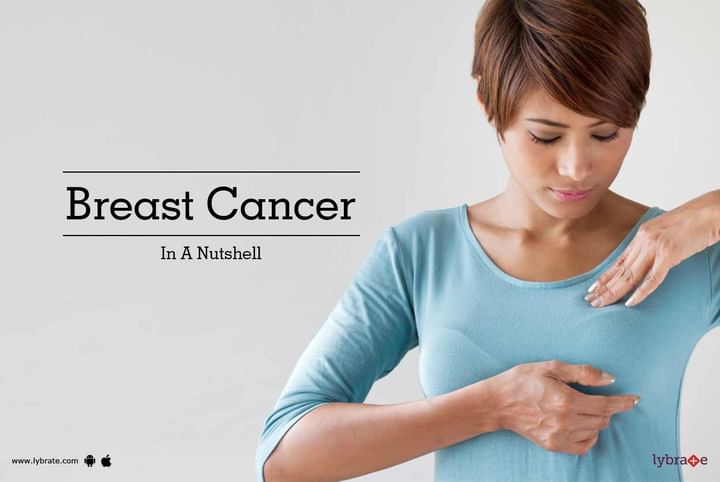Breast Cancer - In A Nutshell
Breast cancer begins when cells in the breast(s) start to grow out of control. It is understood as being the most common cancer, seen predominantly in females, globally. It is reasonably treatable and often curable.
1. Type: Adenocarcinomas constitute more than 95% of breast cancers with infiltrating ductal carcinoma (IDC) being the most common form of invasive breast cancer.
Frequently occurring breast cancers present as one of the following types mainly
1. Ductal Carcinoma In Situ (DCIS): Is the most common type of non-invasive breast cancer and is confined to the milk ducts of the breast. There is no invasion in the basement membrane. Pure DCIS metastasizes rarely. Non comedo cribrioform carcinoma is the most common DCIS found which, when compared to the comedo type, is mostly non-aggressive.
2. Infiltrating Ductal Carcinoma (IDC): Represents majority (about 3/4th) of the breast cancers, and is known to metastasize commonly to bones, lungs and liver.
3. Lobular Carcinoma In Situ (LCIS): Develops in multiple lobules of the breast (bilaterally). LCIS is less commonly seen, compared to DCIS.
4. Infiltrating Lobular Carcinoma (ILC): Represent about a tenth of all breast cancers and tends to metastasize to other regions of the body.
Less commonly occurring breast cancers such as
5. Inflammatory Breast Cancer: Is relatively uncommon and are caused probably owing to viral infections. The breast is warm, red and swollen.
6. Paget’s disease of the nipple: Is a rare form of breast cancer. It begins in the milk ducts and spreads to the nipple and areola.
7. Medullary Carcinoma
8. Mutinous Carcinoma
9. Tubular Carcinoma
10. Phylloides tumor etc all.
2. Gender: Affects the female populace predominantly. However, a small percentage of breast cancer is attributable to the male populace as well.
3. Etiology: No definite cause is known. However, diet, lifestyle, environment, hormonal/ reproductive factors, personal or family history of breast cancer especially in first degree relatives and also any benign breast disease history etc all are known to increase the risk of breast cancers. Specifically, excessive fatty diet, obesity, type 2 diabetes mellitus, benign breast disease, heredity/ inheritance of mutated breast cancer genes 1 (BRCA1) and 2 (BRCA2), smoking, alcohol intake, infertility, estrogen therapy/ hormone replacement therapy (long term) in post menopausal women, delayed age at first pregnancy, nulliparity (not having child), early menstruation, delayed onset of menopause, lactating mothers not breast feeding, exposure to ionizing radiation, sedentary lifestyle, depression, exposure to MMTV virus etc all can potentially increase the risk for breast cancer.
4. Features: Signs & symptoms, of breast cancer, manifest majorly in the following ways
-
Lump/ nodule in the breast that gets attached to the skin of the breast over time. The lump / nodule could be hard and painless with irregular edges or it could also be soft, rounded, tender and painful.
-
Enlarged lymph nodes in the axilla which are palpable.
-
Swelling of whole or a part of a breast. This is even if there is no distinct lump felt.
-
Retraction or thickening of the nipple(s).
-
Pain in the breast or nipple.
-
Discharge from nipple other than breast milk.
-
Irritation/ scaliness of skin over the breast.
-
Redness of nipples
-
Rarely, red, swollen and tender breast.
5. Screening: Is generally recommended for asymptomatic populations goal of which, as usual, is to be able to detect & diagnose breast cancer at an early stage which is potentially curable. It is mostly radiologic with mammography/ USG being instrumental in raising suspicions for further diagnostics (i.e. biopsy) that help detect breast cancer, if any, early.
6. Diagnosis: A self-examination/ clinical exam of the breast(s)/ axilla that reveals a palpable mass prompts the following diagnostics. Abnormal blood test results may be indicative of malignancy, but a follow up imaging/ biopsy is always the gold standard for accurate diagnosis.
- Blood: ER/ PR/ HER2/neu, uPA, PAI-1, CA15-3, CA27.29 etc all tumor markers are helpful.
- Imaging: Mammography/ USG Scan usually, as relevant. Again, CT Scan of abdomen & pelvis and chest, PET CT scan, bone scan etc all help detect metastasis, if any, for cancers in stage III & above.
- Biopsy: either excisional, incisional, fine needle aspiration (FNA) or core biopsy technique, as contextually appropriate, is frequently employed and a histopathological examination (HPE) thereof clinches the diagnosis and the nature of the disease.
7. Treatment: Conventional treatment includes surgery, radiotherapy, hormone therapy/ chemotherapy as deems appropriate. Simultaneously, an adjunctive or integrative naturopathic treatment with suitable complementary & alternative medicines (CAM) too can help improve clinical outcomes and facilitate recovery as would be feasible contextually.
8. Prognosis: Preventive measures, earlier diagnosis and right early treatment is key for an effective therapeutic management & better prognosis. Like most other cancers, the chances of cure for an early stage breast cancer are more. The cure/ recovery chances are influenced by the type, grade, stage of cancer, recurrence and the patient’s general health & vitality etc all. Above-mentioned apart, age, menopause status, lymph node status, ER/ PR/ HER-2/ neu status, size & extent of breast cancer etc all also influence the treatment outlook in breast cancer. The five year survival rate is strongly correlated with the stage of breast cancer.
9. Prevention: Rightly said, prevention is always a better choice. Although genetic risks are difficult to modify, still an increased focus on protective factors and avoidance of the risk factors can be of help. An adherence to a Mediterranean diet, maintaining an ideal body weight and an active lifestyle with due emphasis on regular exercising (for at least 30 minutes daily), de-stressing and relaxation is highly recommended for reducing the risks of breast cancer. A healthy eating plate comprises essentially a low fat diet, fibre rich foods including whole grain cereals, green leafy vegetables cooked using healthy vegetable oils, fresh fruits of all colours as seasonally available and healthy proteins/ fats including fresh fish, poultry, beans, nuts etc all. It is advisable to limit milk/ dairy, preferably of low fat content, to 1 to 2 servings max daily. Although alcohol is optional and is not for everyone, the consumption of the same, if any, has to be strictly in moderation, and is best avoided. Smoking is to be avoided as well. Again, red meat, butter, refined grains, sweets, sugary drinks including carbonated beverages and other high calorie foods etc all, if any, are to be taken sparingly or are best avoided too. Limiting dosage/ duration of hormone therapy, if any, especially to counteract post menopausal symptoms and also avoiding exposure to radiation and environmental pollution can help reduce the risks of breast cancer. Apart from the above-mentioned, for high risk cases, a prophylactic oophorectomy, prophylactic radical mastectomy, long term hormone therapy etc all can help reduce the chances/ risks of developing breast cancer significantly. Breastfeeding is known to confer protection against breast cancer risk too.



+1.svg)
